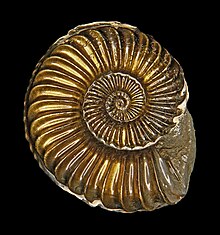Ammonoidea
Ammonoids mga extinct na spiral shelled cephalopods comprising the subclass Ammonoidea. They are more closely related to living coleoids (i.e., octopuses, squid and cuttlefish) than they are to shelled nautiloids (such as the living Nautilus).[1] The earliest ammonoids appeared during the Devonian, with the last species vanishing during or soon after the Cretaceous–Paleogene extinction event. They are often called ammonites, which is most frequently used for members of the order Ammonitida, the only living group of ammonoids from the Jurassic up until their extinction.
- ↑ Klug, Christian; Kröger, Björn; Vinther, Jakob; Fuchs, Dirk (August 2015). "Ancestry, Origin and Early Evolution of Ammonoids". In Christian Klug; Dieter Korn; Kenneth De Baets; Isabelle Kruta; Royal H. Mapes. Ammonoid Paleobiology: From macroevolution to paleogeography. Topics in Geobiology 44. 44. Springer. pp. 3–24. doi:10.1007/978-94-017-9633-0_1. ISBN 978-94-017-9632-3.
| Ammonoids | |
|---|---|

| |
| Specimen of Pleuroceras solare, from the Lower Jurassic of Bavaria, Germany | |
| Sayantipiko na klasipikasyon | |
| Kahadean: | Animalia |
| Paylo: | Mollusca |
| Klase: | Cephalopoda |
| Subklase: | †Ammonoidea Zittel, 1884 |
| Orders | |
